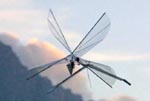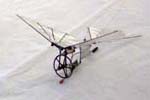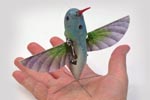Manned Ornithopters
Full History
History Archive
Getting Started
How to Design & Build
Competition Info
Design Tools
Design Manual
Newsletter
Free Plans
Teachers Guide
Web Site Links
About the Society
Contact Info


|
 |

Micro
Air Vehicle Ornithopters
Micro air vehicles,
also known as MAVs, result from the US military's interest in miniature
spying devices. The Defense Advanced Research Projects Agency (DARPA)
has heavily funded some of these projects. Small radio-controlled
ornithopters can carry a camera payload for spying inside buildings.
The ultimate goal is to produce an ornithopter so small and lifelike
that it can pass as a real insect or small bird, going unnoticed
as it performs its deadly mission. With recent advances in hobby
radio control products, now you can build your own micro-sized ornithopters
and hopefully find some non-violent purpose for them.

|
|
2000.
The MicroBat, developed by Aerovironment and Caltech, was the
first micro-sized ornithopter resulting from MAV funding. It
had three-channel radio control and used one of the lithium-polymer
batteries which had just become available.
|

|
|
2000s.
At the International Micro Air Vehicle Competition, university
teams compete to see who can perform the most pylon circuits
with the smallest ornithopter. This annual event is held in
a different location each year and also includes rotary-driven
MAVs. (University of Florida entry is shown.)
|

|
|
2002.
Although some hovering freeflight ornithopters had been built
by hobbyists, Mentor, developed at University of Toronto, was
the first hovering ornithopter with radio control. Hovering
is important for MAV applications that require maneuvering in
tight spaces. |

|
|
2006.
Delfly, developed at the Technical University of Delft and Wageningen
University, is able to transition between hovering and forward
flight. These ornithopters also carry a small video camera.
The live images are analysed by a computer on the ground, giving
Delfly the capacity for autonomous navigation.
|

|
|
2007.
This prototype developed by Nathan Chronister can hover and
perform aerobatic maneuvers. Though developed for recreational
use, this ornithopter achieved a MAV benchmark because it is
the size and weight of a real hummingbird. The ornithopter weighs
3.3 grams and has a 15 cm wingspan. |

|
|
2007.
Currently the world's smallest radio-controlled ornithopter,
this one constructed by Petter Muren has a wingspan of 10 cm
and weighs only 1 gram. |

|
|
2010.
Aerovironment's Nano Hummingbird, while not especially small,
was a huge breakthrough in MAV ornithopter research because
of its gyroscopically stabilized flight without any tail surfaces. |
|
 |








